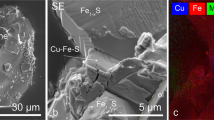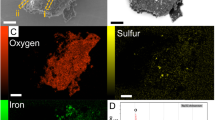Abstract
TANAKA et al.1 have suggested that there must be barium-rich micro-components in the Allende meteorite. We have confirmed this prediction by discovery of barium-rich particulates (see ref. 2). Figure 1 shows diffuse distribution of Ba-rich particles as well as their clusters; each of apparent particles seems to be composed of finer particulates probably of submicron size. Tanaka and Okumura2 showed that the Ba-rich spots are also high in content of titanium. Figure 2 shows the areal overlapping of the distribution of Ba with that of Ti. Relatively sparse dots for Ti are due to shorter scanning time than for Ba.
This is a preview of subscription content, access via your institution
Access options
Subscribe to this journal
Receive 51 print issues and online access
$199.00 per year
only $3.90 per issue
Buy this article
- Purchase on Springer Link
- Instant access to full article PDF
Prices may be subject to local taxes which are calculated during checkout
Similar content being viewed by others
References
Tanaka, T., Nakamura, N. & Masuda, A. Geochem. J. 10, 111–114 (1976).
Tanaka, T. & Okumura, K. Geochem. J. (in the press).
Palme, H. & Wlotzka, F. Earth planet. Sci. Lett. 33, 45–60 (1976).
Reid, A. M., Williams, R. J., Gibson, E. K., Jr. & Fredriksson, K. Meteoritics 5, 218 (1970).
Grossman, L. & Clarke, S. P. Jr. Geochim. cosmochim. Acta 37, 635–649 (1973).
Grossman, L. Geochim. cosmochim. Acta 36, 597–619 (1972).
Schnetzler, C. C. in Handbook of Elemental Abundances in Meteorites (ed. Mason, B.) 413–417 (Gordon and Breach, New York, 1971).
Gopalan, K. & Wetherill, G. W. in Handbook of Elemental Abundances in Meteorites (ed Mason, B.) 297–302 (Gordon and Breach, New York, 1971).
Goodenough, R. D. & Stenger, V. A. Comprehensive Inorganic Chemistry 1, (ed. Bailar, J. C. Jr. et al.) 651–653 (Pergamon, Oxford, 1973).
von Hippel, A. R. Dielectrics and Waves (Wiley, New York, 1954).
Brecher, A., Briggs, P. L. & Simmons, G. Earth planet. Sci. Lett. 28, 37–45 (1975).
Larimer, J. W. & Anders, E. Geochim. cosmochim. Acta 31, 1239–1270 (1967).
Anders, E. Ace. Chem. Res. 1, 289–298 (1968).
Author information
Authors and Affiliations
Rights and permissions
About this article
Cite this article
MASUDA, A., TANAKA, T. How did barium titanate particulates stick together in the nebula?. Nature 267, 231–233 (1977). https://doi.org/10.1038/267231b0
Received:
Accepted:
Issue Date:
DOI: https://doi.org/10.1038/267231b0
This article is cited by
Comments
By submitting a comment you agree to abide by our Terms and Community Guidelines. If you find something abusive or that does not comply with our terms or guidelines please flag it as inappropriate.



